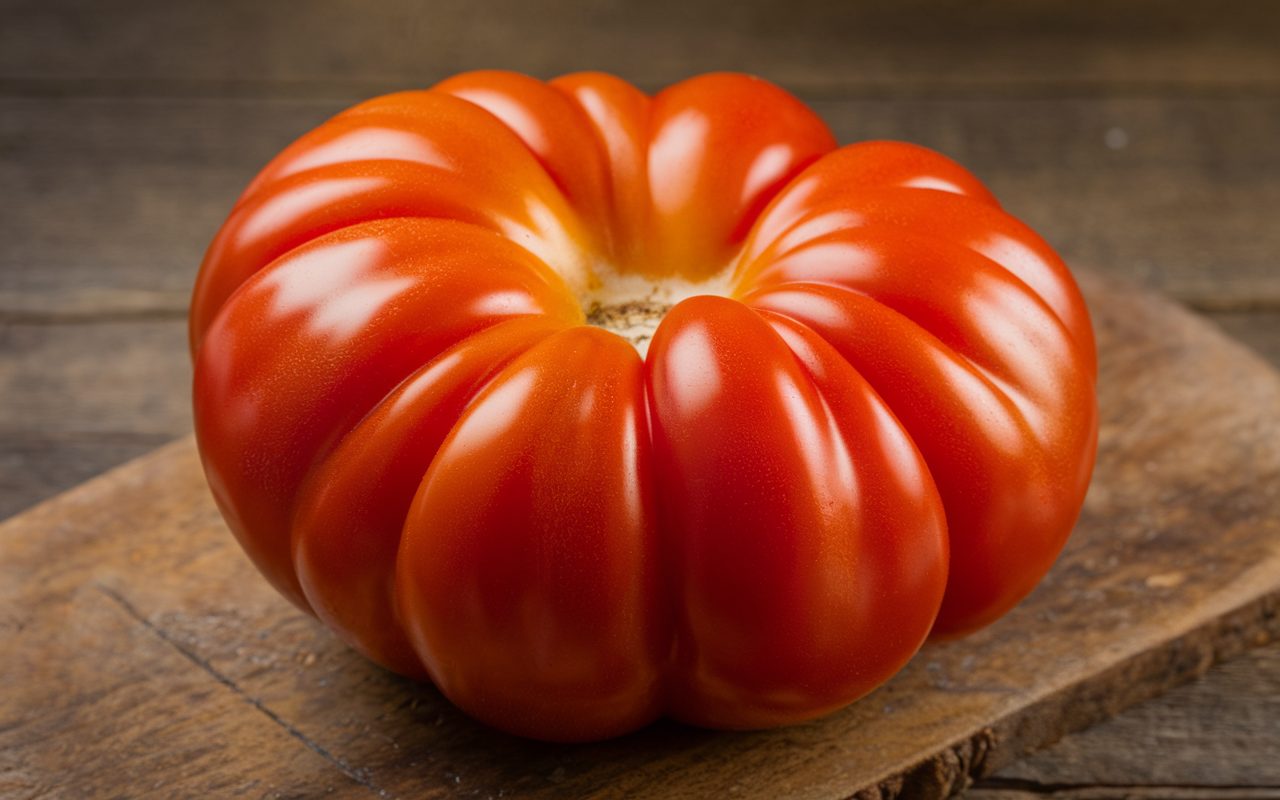Beef tomatoes are a favorite in many kitchens, known for their rich flavor, large size, and versatility. This article will delve into everything you need to know about beef tomatoes—from their origins to how to use them in your cooking. Whether you’re growing them in your garden or picking them up from the local market, this guide will help you get the most out of this delicious vegetable.
What is a Beef Tomato?
A beef tomato is a variety of tomato known for its large size and meaty texture. It’s typically much larger than regular tomatoes, with some varieties weighing up to 2 pounds. These tomatoes have a dense, firm flesh with fewer seeds, making them perfect for slicing and using in recipes where you need a juicy, meaty texture.
Beef tomatoes are often called beefsteak tomatoes, but the term “beef tomato” is used to describe larger, more robust varieties. They come in different colors, including red, yellow, and even purple, but the classic beef tomato is usually red.
Unlike smaller tomatoes, beef tomatoes are ideal for making sauces, salsas, or adding a fresh touch to your dishes. Their hearty nature also makes them an excellent choice for grilling or roasting.
Why is it Called a Beef Tomato?
The term “beef” in beef tomato refers to the tomato’s meaty, thick texture, which resembles that of beef. The flesh of a beef tomato is denser and juicier compared to most other types of tomatoes, giving it a hearty, robust feel. While not directly related to the meat, the comparison to beef highlights the substantial, fleshy nature of this variety.
Related Reading:
- History of Tomatoes: From Ancient Times to Modern Kitchens
- How to Grow Beefsteak Tomatoes in Your Garden
The Many Uses of Beef Tomatoes
Beef tomatoes are incredibly versatile, making them perfect for a variety of culinary applications. Here are some popular ways you can use these tomatoes:
- Fresh Slices for Sandwiches and Salads: Beef tomatoes are large enough to be sliced into thick, juicy pieces, making them ideal for sandwiches and salads.
- Salsas and Sauces: Due to their meaty texture, beef tomatoes are perfect for making tomato-based sauces or salsas. Their low seed content makes them ideal for smooth sauces.
- Grilling: You can grill beef tomatoes just like other vegetables. Their thick flesh holds up well to grilling, and they develop a smoky, rich flavor.
- Stuffing: Their large size also makes them perfect for stuffing. Fill them with grains, meats, or vegetables for a hearty meal.
Beef tomatoes can be used in a variety of dishes, from simple salads to intricate stews. The options are endless!
Health Benefits of Beef Tomatoes
Aside from their delicious taste, beef tomatoes are also packed with health benefits. Here are a few reasons why you should incorporate more beef tomatoes into your diet:
- Rich in Vitamins and Nutrients: Beef tomatoes are an excellent source of Vitamin C, potassium, and antioxidants, which support overall health.
- Low in Calories: Like most tomatoes, beef tomatoes are low in calories, making them a healthy choice for weight management.
- Contains Lycopene: Lycopene is a powerful antioxidant found in tomatoes, which is linked to a reduced risk of chronic diseases such as heart disease and cancer.
How to Grow Beef Tomatoes at Home
If you want to enjoy the freshness of beef tomatoes all year round, why not grow them at home? Beef tomatoes are easy to cultivate, whether you have a small garden or a larger backyard. Here’s how to get started:
1. Choose the Right Variety
There are many varieties of beef tomatoes, so choose one that suits your climate and space. Popular options include Brandywine and Big Beef.
2. Plant in Full Sunlight
Beef tomatoes thrive in full sunlight, so pick a location that gets at least 6-8 hours of direct sun per day.
3. Prepare the Soil
Tomatoes prefer well-drained soil that’s rich in organic matter. Add compost or aged manure to improve soil quality.
4. Water Regularly
Beef tomatoes need consistent moisture, but avoid overwatering, which can cause root rot. Water at the base of the plant, not on the leaves.
5. Prune and Support
Tomato plants can get quite large. Prune the lower leaves and use stakes or cages to support the plant as it grows.
1. Beef Tomatoes vs. Other Tomato Varieties
This section can compare beef tomatoes to other popular varieties, such as Roma, cherry, and heirloom tomatoes. Highlight differences in taste, texture, and common culinary uses. This can help readers understand when and why to choose beef tomatoes over other types.
- Flavor Comparison: Discuss the differences in taste between beef tomatoes and smaller varieties.
- Texture: Contrast the meaty texture of beef tomatoes with the juicier, more delicate texture of other varieties.
- Best Uses: Explain which dishes each tomato variety is best for.
2. Storing Beef Tomatoes
While beef tomatoes are delicious, storing them properly is essential for maintaining their flavor and texture. This section can guide readers on how to store beef tomatoes at their peak freshness.
- Room Temperature vs. Refrigeration: When to store them at room temperature and when to refrigerate.
- Ripening Tips: If you buy under-ripe beef tomatoes, tips for ripening them at home.
- Freezing Beef Tomatoes: Explain how to freeze beef tomatoes if they start to over-ripen.
3. Tomato Varieties Similar to Beef Tomatoes
If someone can’t find beef tomatoes or wants to experiment with other varieties, this section can introduce alternatives like:
- Heirloom Tomatoes: Known for their rich flavor and large size.
- Big Beef Tomatoes: A hybrid variety that is similar in size and texture to beefsteak.
- Cherokee Purple Tomatoes: Similar in texture and slightly more tangy.
Discuss their flavor profiles, how they compare to beef tomatoes, and when to use them as substitutes.
4. Beef Tomatoes in International Cuisines
In this section, you can explore how different cultures use beef tomatoes in their cooking. Beef tomatoes may be versatile, but they also appear in regional dishes.
- Mexican Cuisine: In salsa and tacos.
- Italian Cuisine: As a base for sauces and in salads.
- Mediterranean Dishes: In stews or stuffed tomatoes.
- Middle Eastern Recipes: Often used in salads and roasted dishes.
5. Beef Tomato-Based Recipes to Try
Share some specific recipes that highlight beef tomatoes. You can include a short description and link to the full recipe page on your website. These could be:
- Stuffed Beef Tomatoes: A recipe with rice, herbs, and ground meat.
- Beef Tomato Salad: A fresh, easy recipe with herbs, vinegar, and olive oil.
- Roasted Beef Tomatoes: A simple side dish that pairs well with meat.
- Beef Tomato Soup: A hearty, comforting dish for cold weather.
6. Beef Tomatoes and Sustainable Farming
This section can highlight the sustainability of growing beef tomatoes at home versus buying them from the store. Discuss organic farming practices and how these practices benefit both the environment and consumers.
- Benefits of Home Gardening: How growing beef tomatoes at home can reduce your carbon footprint.
- Sustainable Farming: Discuss how sustainable farming practices, such as using fewer pesticides, affect the quality of beef tomatoes.
- Local Farming and Seasonal Eating: The importance of supporting local tomato growers and eating tomatoes when they are in season.
7. How to Preserve Beef Tomatoes
Explain how to preserve beef tomatoes if you grow them in your garden and have an abundance during peak season. Offer various preservation methods:
- Canning: How to can beef tomatoes for later use in sauces and soups.
- Drying: Tips for drying beef tomatoes to create sun-dried tomatoes.
- Freezing: A simple method for freezing beef tomatoes for year-round use.
8. Beef Tomatoes and Their Impact on Local Economies
This section could discuss the economic impact of beef tomato farming in different regions. You can explore how tomato farmers contribute to local economies and discuss any challenges they face in cultivating these large, meaty fruits.
- Market Demand for Beef Tomatoes: How local farmers grow and sell beef tomatoes at farmers’ markets and grocery stores.
- Impact of Climate Change: How weather patterns and environmental changes may affect beef tomato production.
Common Mistakes to Avoid When Cooking with Beef Tomatoes
While beef tomatoes are delicious and versatile, there are a few common mistakes to avoid when cooking with them:
- Using them in Dishes that Need Small Tomatoes: Beef tomatoes are large and meaty. They’re not ideal for dishes that require smaller, more delicate tomatoes.
- Overcooking Them: Because of their dense flesh, beef tomatoes take longer to cook than regular tomatoes. Be mindful not to overcook them, as they can become mushy.
- Not Removing the Seeds for Sauces: If you’re making a sauce, you may want to remove the seeds and excess juice from beef tomatoes. This will give you a smoother, more concentrated sauce.
Frequently Asked Questions (FAQs)
Why is it called a beef tomato?
The name “beef” refers to the tomato’s meaty texture, which is thick and firm, similar to the texture of beef.
What are beef tomatoes good for?
Beef tomatoes are great for slicing, making salsas, creating sauces, grilling, and even stuffing. Their dense flesh makes them versatile for various dishes.
Do beef tomatoes taste like beef?
No, beef tomatoes do not taste like beef. The term “beef” refers to their meat-like texture, not their flavor. They have a fresh, slightly tangy tomato flavor.
What’s the difference between tomato and beefsteak tomato?
Beefsteak tomatoes are a specific variety of large tomatoes with dense, meaty flesh. Regular tomatoes are generally smaller and have a higher water content.
Conclusion
Beef tomatoes are a fantastic addition to any kitchen. Their meaty texture and rich flavor make them versatile for a wide range of recipes, from fresh salads to hearty sauces and salsas. Whether you’re cooking a family meal or growing them in your garden, beef tomatoes are a delicious and healthy choice.
Incorporate these large, juicy tomatoes into your next dish, and enjoy the flavorful boost they provide!

